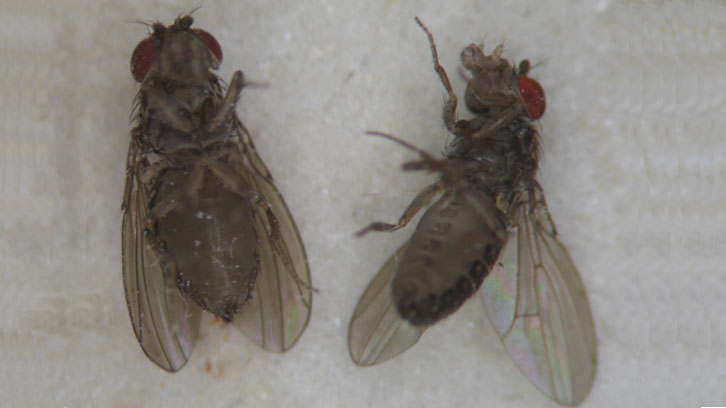Increase of Genome Size in Drosophila Hybrids

Transposable elements are mobile DNA sequences representing 15% of the Drosophila genome. Stress conditions such as interspecific hybridization can cause unexpected episodes of sequence mobilization (transposition). Previous studies showed that the mobilization frequency increased significantly in the genome of hybrid individuals compared to their parents. However, a relationship between the burst of transposition events and increases in genome size have been widely described in plants, but had not yet been described in animals.
Figure 1: A) Diagram of the crosses. B) Graph of genome size of hybrid females.
This work was carried out by Valèria Romero-Soriano in collaboration with a French laboratory and supervised by Dr. Mª del Pilar García Guerreiro. The authors studied the impact of interspecific hybridization on genome size of hybrid males and females for four generations (Figure 1A). For this purpose the flow cytometry technique was used in order to compare the hybrid genome size at each generation to that of the parental species. Among the most relevant results they found that whereas a significant genome increase is observed from the second generation in hybrid females (Figure 1B), this increase was not significant in males. The most relevant differences were observed in females resulting from the first backcross (Fig. 1B).
These results are in agreement with the increase of transposition rates observed in previous studies in hybrids. However, despite the genome size being higher than expected, in all backcrosses, its value decreases along generations (Figure 1B). This result can be explained by failures in mobile element regulatory mechanisms which will be larger the higher the difference between genomes involved in crosses. Given that during backcrosses the genome of a parental species (D. buzzatii, Figure 1A) is repeatedly introgressed, this would mitigate the genome incompatibilities resulting in a lower effect of hybridization on transposition rates.
UAB scientists showed that the increases of transposition activity, previously observed in D. buzzatii-D. koepferae hybrids, has an impact on the genome size of hybrid females. Therefore, they are pioneers in demonstrating that genome size can be increased as consequence of DNA sequence mobilization events in animals.
References
Romero-Soriano, Valèria; Burlet, Nelly; Vela, Doris; Fontdevila, Antonio; Vieira, Cristina; García Guerreiro, María Pilar. Drosophila Females Undergo Genome Expansion after Interspecific Hybridization. Genome Biology and Evolution. 2016, vol. 8, num. 3, p. 556-561. doi: 10.1093/gbe/evw024.


